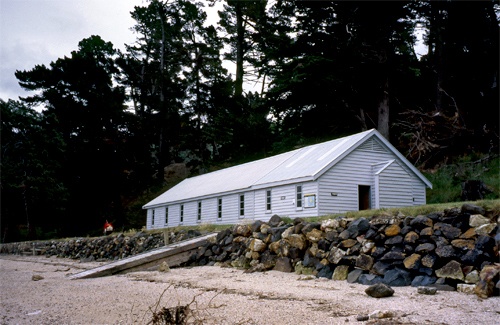
Quail Island, Lyttelton Harbour (1875)
Our Ellis Island?
This may surprise you. Although many New Zealanders can trace their roots back to 19th-century migrants, just two immigration-related buildings survive from this period, both from quarantine stations: on Quarantine Island in Otago Harbour and Quail Island in Lyttelton Harbour.
Māori knew Quail Island as Ōtamahua, the ‘place to gather sea-bird eggs’. Bird life must have been important, for Captain William Mein Smith named it after the now-extinct native quail. Europeans farmed the island from 1851 but its importance increased after 1874 when the provincial government accepted Thomas Potts’s offer to use it as a quarantine station. Sir Julius Vogel’s assisted migration scheme was peaking and immigrants were flooding into the southern provinces especially. New Zealand’s European population surged from 60,000 in 1860 to 470,000 by 1881. Although most migrants arrived fit and well, the authorities implemented disease prevention measures at the major ports. Before anyone disembarked, officials checked the health of the government migrants and the condition of the ship, and heard complaints. Ships with sick people aboard had to raise the yellow flag and go into quarantine, a dismal introduction to the New World for people who had already been cooped up for three to five uncomfortable months at sea.
Construction started before the island’s sale could be completed, so the government built cheaply and simply. In February 1875 the Rakaia (which had lost 11 passengers and still had 100 mumps cases aboard) became the first ship to use Quail Island. It would not be the last, but with migration tapering off in the late 1870s and steam taking over from the mid-1880s, the need to quarantine people declined sharply. From 1881 livestock were also detained here, most famously the dogs and ponies used by Antarctic explorers. Between 1901 and 1929 the Shackleton, Scott and Byrd expeditions all used Quail Island.
But sickness still drove people here. In 1918 victims of the influenza epidemic were sent here as Canterbury struggled to meet the crisis. Between 1906 and 1925 there was also a small leper colony. Just a few minutes’ walk from the barracks you will find the walls, concrete foundations and drain channels from the leper colony that sat on its own isolated terraces. Another few minutes’ walk away a solitary grave lies behind a neatly painted white picket fence. It belongs to the only leper to die here, 20-year-old Ivan Skelton, who was visiting relatives at Westport in 1918 when he was diagnosed with the ancient curse. Shipped off to Quail Island, he died five years later, far from his family.
Finally, do not miss the ‘Ships’ Graveyard’ on the western side of the island. In the 19th and early 20th centuries old hulks 'graced' most major ports. Otago and Lyttelton harbours still contain ships’ graveyards. Quail Island’s is the bigger. Depending on the state of the tide, you may make out the decaying remains of eight vessels: the Queen, Mullogh, Lyttelton, La Plata, Waiwera, Frank Guy, Darra and Belle Isle. Most prominent are the early iron steamer Mullogh (1859), right up on the beach; the long frames of the former tea clipper and migrant ship Darra (1865), beached parallel to the shore; and the Frank Guy, a bit further out.
The Department of Conservation administers the island, which can be reached by ferry once or twice daily, depending on the season. Allow at least two hours to walk around it. There is plenty to see and in summer the beach is fine for swimming. You will also see traces of a quarry that once supplied ballast to sailing ships, relics from the island’s long farming history and some stunning sea cliffs.
Further information
This site is item number 47 on the History of New Zealand in 100 Places list.
On the ground
Several sites and features are interpreted.
Websites
- Heritage New Zealand List entry
- DOC visitor information
- NZ History interactive
- Quarantine islands - Te Ara
- Quail Island Ecological Restoration Trust
- New Zealand Maritime Record
Book
- Peter Jackson, Quail Island: a link with the past, Department of Conservation, Wellington, 1990









Community contributions